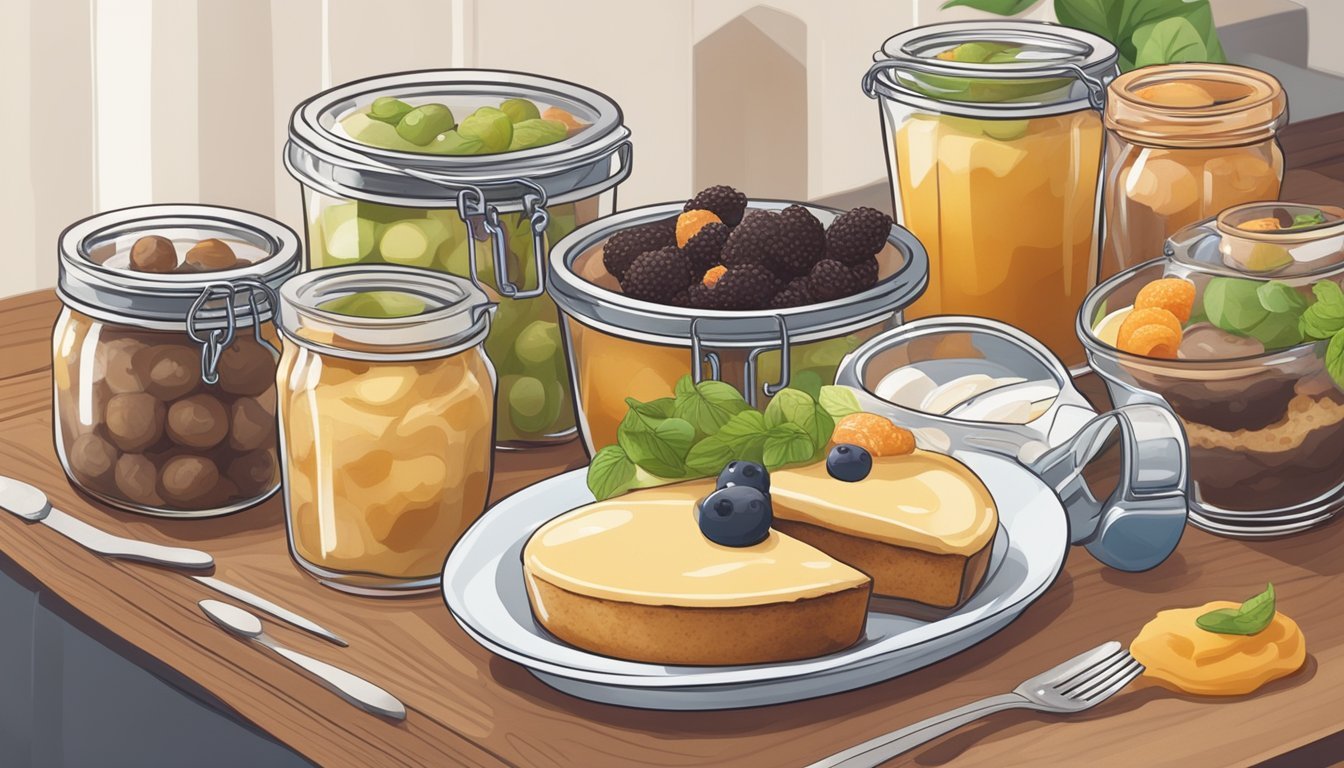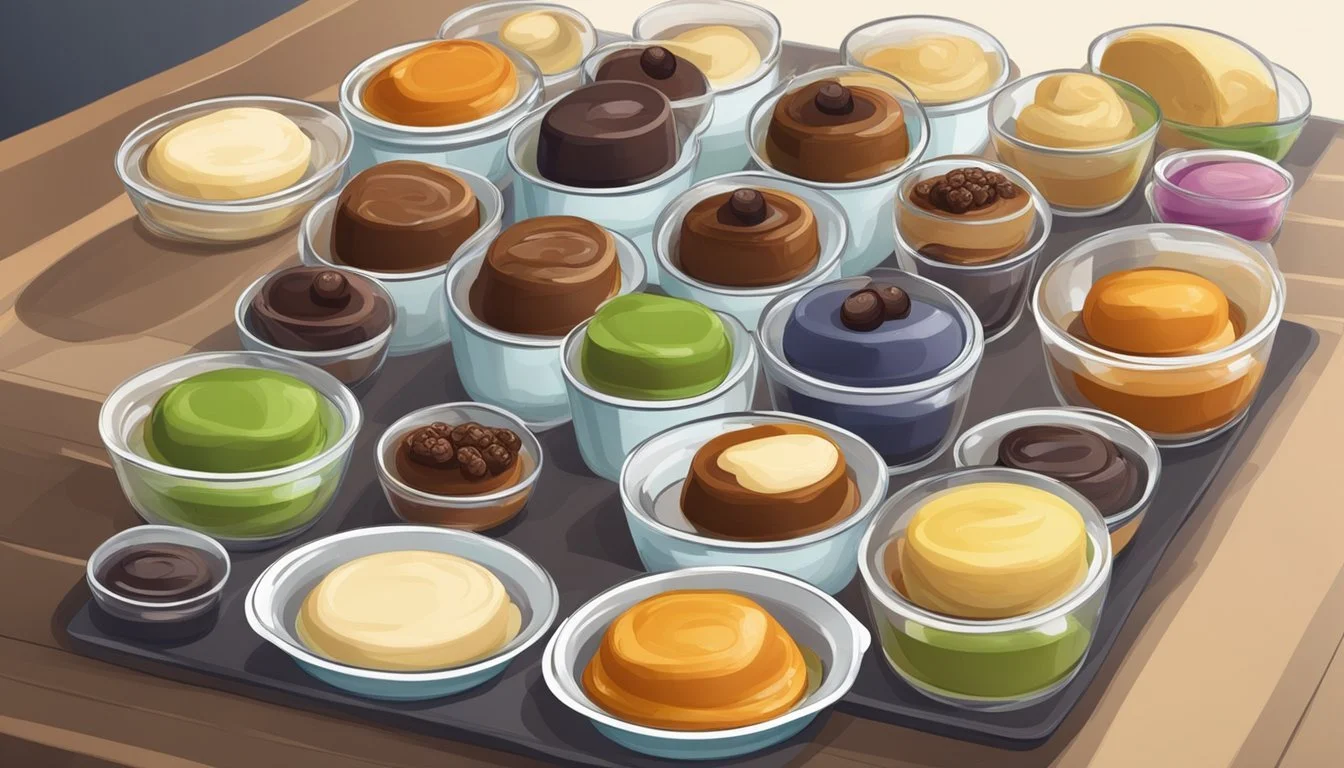How Long Do Freshly Prepared Puddings Last?
Shelf Life and Storage Tips
Understanding the shelf life of freshly prepared puddings is crucial for both safety and quality. Puddings, whether homemade or store-bought, are beloved desserts that come in a variety of flavors. They typically consist of milk or cream, sugar, and a thickening agent such as cornstarch or eggs. These ingredients can be sensitive to bacterial growth if not stored properly. Hence, knowing how long they last is key to enjoying this treat at its best.
Homemade puddings should be consumed within 3-5 days when stored in the refrigerator in an airtight container. The freshness of the ingredients and the temperature at which the pudding is kept are key factors that affect its shelf life. A refrigerator set at or below 40°F helps in preserving the quality and safety of the pudding by slowing down the growth of bacteria.
Store-bought puddings also come with a best before date, which indicates the last date the manufacturer guarantees the product's optimal flavor and quality. However, this date is not an absolute indicator of safety, and it is common for unopened pudding mixes to last up to a month past this date if kept either in the pantry or refrigerator. Once opened or prepared, store-bought puddings should be treated similarly to homemade ones, with an expected refrigerated shelf life of up to a week.
Understanding Pudding Components
The shelf life of freshly prepared puddings is highly influenced by its individual ingredients and how they interact with each other. The presence of dairy, eggs, and preservatives plays significant roles in both the flavor development and the longevity of the pudding.
Ingredients Impact on Shelf Life
The components of a pudding mix such as milk, sugar, flavoring agents, and thickening additives like cornstarch or cocoa powder each contribute to the perishability of the final product. Milk and cream, being perishable, are prone to bacterial growth which can reduce shelf life. Sugar, while adding sweetness, also acts as a preservative to some extent.
Role of Dairy and Eggs
Dairy products and eggs are the cornerstone ingredients in traditional pudding recipes, imparting both richness and a creamy texture. Milk and cream provide a favorable environment for bacterial growth if not stored correctly. Similarly, eggs are essential for structure and emulsification but also demand proper refrigeration to prevent spoilage.
Preservatives and Stabilizers
Commercial puddings often include preservatives and stabilizers such as palm oil or additional additives to extend their longevity. Stabilizers like cornstarch or cocoa powder help maintain the pudding's consistency over time, whereas preservatives inhibit microbial growth, enhancing shelf stability.
Signs of Spoilage
When assessing whether freshly prepared pudding has gone bad, one should look for distinct changes in visual appearance, smell and taste, as well as alterations in texture.
Visual Indicators
The presence of mold is the most obvious visual sign of spoilage in pudding. Discoloration or any unusual spots that do not correspond with the ingredients used also indicate that the pudding should not be consumed. Fresh pudding typically has a consistent color; variations might suggest spoilage.
Smell and Taste
A foul smell is a clear indicator that the pudding has spoiled. Freshly prepared pudding should have a sweet smell indicative of its ingredients. If the pudding emits a sour smell or any off odor, it is likely unsafe for consumption. The taste should be disregarded as a test for spoilage; if the smell is off, the pudding should not be tasted.
Texture Changes
The texture of fresh pudding should be smooth and creamy. Any separation of liquid or noticeable texture changes, such as lumps or a watery layer, can suggest spoilage. These changes often accompany a breakdown in the pudding's structure and indicate that it is past its prime.
Optimal Storage Conditions
To ensure the longevity and quality of freshly prepared puddings, specific storage conditions must be maintained. These include controlling temperature and moisture, as well as selecting the proper containers and packaging.
Temperature and Moisture
The refrigerator should maintain a constant temperature at or below 40°F (4°C) to keep pudding fresh. Moisture levels must be low, as excess humidity can lead to spoilage. Puddings should not be stored in the pantry where temperatures and moisture are less controlled.
Containers and Packaging
Puddings must be stored in:
Airtight containers: These prevent the absorption of other food odors and maintain pudding quality.
Plastic wrap: Directly covering the surface of the pudding with plastic wrap before sealing with a lid can help keep out air and contaminants.
Freezer bags: For extended storage, place the pudding in freezer bags and remove as much air as possible.
Using containers with a tight-fitting lid helps secure the pudding from external contaminants. If freezing, ensure that the packaging is both moisture-resistant and provides a secure seal to avoid freezer burn.
Shelf Life by Type
The shelf life of pudding varies by type—a crucial consideration when buying or preparing this dessert. Whether one opts for the homemade route, selects a store-bought option, or uses a pudding mix, each category comes with its own expected shelf life.
Homemade Pudding
Homemade puddings, including traditional flavors like chocolate and vanilla, as well as varieties such as rice pudding and banana pudding, typically last up to 7 days when refrigerated. They should be stored in an airtight container at or below 40°F (4°C) to maintain their quality and safety.
Store-Bought Pudding
Store-bought puddings, which come in formats like pudding cups or in larger containers, display an expiration date on the packaging. Once opened, they should be consumed within 3-5 days if kept refrigerated. It is important to adhere to the manufacturer's guidelines for the best indication of shelf life.
Pudding Mixes
The longevity of pudding mixes extends considerably beyond their best before dates. Dry pudding mix can last for several months in the pantry. After preparation, however, similar to homemade pudding, the shelf life reduces to approximately 7 days in the refrigerator. For instant pudding varieties, quality may begin to diminish after the week mark.
Expiration and Food Safety
The longevity of freshly prepared puddings hinges on understanding expiration dates and recognizing the risks of eating expired products. The section below unfolds the importance of these aspects from a food safety perspective.
Understanding Expiration Dates
Manufacturers often provide a best before date on their products, and this holds true for pudding as well. This date indicates the time frame for which the manufacturer guarantees the product's optimal quality and flavor, but it is not a definitive indication of safety. Pudding may still be safe to consume after this date, provided it has been stored correctly and shows no signs of spoilage.
Sell-by date: Often confused with expiration dates, sell-by dates are intended more for retailers and indicate how long a product should be displayed for sale.
Expiration date: This is the date beyond which the product might not maintain its quality or begin to degrade in terms of taste, texture, or nutritional value.
Risks of Eating Expired Pudding
Consuming expired pudding can present food safety issues, including possible food poisoning. To assess whether pudding is safe, one must look for signs that the product has gone bad:
Smell: A foul or off-putting odor indicates spoilage.
Appearance: Discoloration or mold growth also warrants immediate disposal.
Texture: Any unexpected changes in texture, such as lumps or excessive liquid separation, can suggest that the pudding is no longer safe to consume.
Even after the best before date, it is crucial to rely on these sensory evaluations to determine safety as eating expired pudding can lead to discomfort or illness from foodborne pathogens.
Best Practices for Prolonging Freshness
Maximizing the shelf-life of freshly prepared puddings is essential to enjoy their flavor and quality for as long as possible. Two key methods to ensure puddings remain fresh involve the use of freezing techniques and proper sealing.
Freezing and Thawing
Freezing Pudding: To freeze pudding, one should ensure the dessert is cool before placing it into the freezer. Freezing at 0°F (-18°C) is ideal for preserving freshness. Airtight containers or freezer-safe ziplock bags are suitable to prevent freezer burn and preserve flavor.
Steps for Freezing:
Allow pudding to cool to room temperature.
Portion the pudding into serving sizes.
Transfer into airtight containers or ziplock bags.
Label with the date of freezing.
Thawing Pudding: Thawing should be done in the refrigerator to maintain safety and flavor. It is important to note that texture changes may occur due to freezing, which can affect the creaminess of the pudding.
Thawing Process:
Place the frozen pudding in the refrigerator.
Allow it to thaw gradually for several hours or overnight.
Stir the pudding before serving to even out the consistency.
Proper Sealing Techniques
Refrigeration: Store pudding in the refrigerator at a consistent temperature of 40°F (4°C) or below to slow down the growth of bacteria. Puddings without preservatives rely on low temperatures to extend shelf-life.
Air-Tight Containers: Utilize air-tight containers to seal in freshness and protect from contaminants. Properly sealing prevents pudding from absorbing odors from other foods and stops it from drying out.
Use containers with tight-fitting lids or sealable bags.
Remove as much air as possible before sealing to minimize oxidation.
Ensure containers are free from cracks or gaps.
Following these storage instructions can considerably extend the enjoyment of homemade puddings beyond their typical refrigerated shelf-life of 3-5 days, offering a longer window to savor their taste and texture.
Special Considerations
When assessing the shelf life of freshly prepared puddings, one must account for factors such as type and methods to minimize risk of spoilage. These nuances influence both the pudding's quality and safety.
Differences in Pudding Variants
Different pudding variants may have distinct shelf lives due to their ingredients and recipes. Store-bought puddings typically come with a best before date and can be shelf-stable due to preservatives, often lasting weeks or months unopened. In contrast, homemade puddings lack these additives and can last about 3-5 days in refrigeration. For example, puddings with fruit may spoil faster due to moisture content that can encourage mold growth. Furthermore, the flavor and brand could imply different preservatives or stabilizers, affecting longevity.
Traditional dairy-based puddings: Expect a refrigerated shelf life of up to 7 days.
Vegan or non-dairy puddings: These may last slightly longer due to the absence of dairy, a common spoilage culprit.
Puddings containing fresh ingredients: Incorporation of fresh fruit or eggs may reduce the shelf life due to faster spoilage rates.
Preventing Contamination
To extend the shelf life of pudding, proper storage and handling are essential to prevent the growth of bacteria. Freshly prepared pudding should be stored in an airtight container to avoid leaking and absorption of odors. It's also crucial to use clean utensils when serving to minimize the introduction of bacteria and markers of contamination.
Temperature: Pudding should be kept at or below 40°F to deter bacterial growth.
Leftovers: They should be promptly refrigerated after serving, ideally within two hours.
Containers: Use sealed containers to protect against contaminants and odors.
Hygiene: Only use clean utensils to serve or scoop pudding to prevent introducing bacteria.
By considering these key aspects, one can help ensure the safety and enjoyability of pudding during its shelf life.









